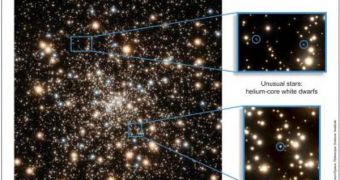In a recent Hubble image, astronomers have observed a very peculiar type of white dwarfs, in a globular cluster containing some of the Universe's oldest star remnants. The 24 celestial bodies, of which 18 have never before been seen, are made up almost entirely of helium, instead of the carbon and oxygen these formations usually contain. The find represents the first group of helium-based white dwarfs to have ever been discovered in such an old cluster, and it raises questions about what exactly was it that cut the former stars' life short.
“Helium-core white dwarfs have only about half the mass of typical white dwarfs, but they are found concentrated in the center of the cluster. With such low masses, the helium-core white dwarfs ought to be floating all around the cluster, according to theory. The fact that we find them only in the central regions suggests that they have heavy companions – partner stars that anchor them to the cluster center,” San Francisco State University Physics and Astronomy Professor Adrienne Cool explained.
She has co-authored a scientific study detailing the find with graduate student Rachel R. Strickler. The paper has been accepted for publication in the upcoming July 1st issue of the Astrophysical Journal. The researcher said that the white dwarfs' orbital dance around their partner stars was the most likely reason why they hadn't been spread thinly across the clusters, and remained stuck in the center of the formation.
“This is the first time that helium-core white dwarf stars have been discovered in partnerships with other white dwarfs in a globular cluster. This large sample allows us to answer questions about the mass and nature of the partner stars, and the prevalence of these kinds of binaries in the globular cluster,” Cool added.
The star cluster the study has been focused on is called NGC 6397 and is located about 7,200 light-years away from Earth. Actually, it was Cool and colleagues that discovered the first three helium-based white dwarfs in the cluster back in 1998. Since then, some additional three have been unveiled, but the recent investigation revealed 18 more.
The role of binary star systems in globular clusters is little understood at this point, but astrophysicists believe that their continuous movements provide energy to the cluster, preventing black holes from forming. In the specific case of NGC 6397, astronomers think that between one and five percent of the stars inside will end up as helium-based white dwarfs. “It may not sound like a lot, but it doesn't take many binaries to stir things up,” Cool concluded.

 14 DAY TRIAL //
14 DAY TRIAL //